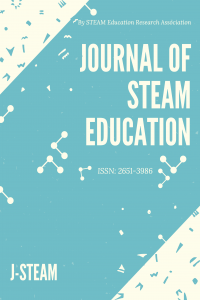Acquisition and use of Environmental Education in Solid Waste Management Practices
Acquisition and use of Environmental Education in Solid Waste Management Practices
Environmental education;, Environmental literacy;, reduce;, recycling reuse, solid waste management,
___
- 1. Afon, A. O. (2007). Informal sector initiative in the primary sub-system of solid waste management in Lagos, Nigeria. Habitat International 31.2:193-204 (11 pages). https://www.researchgate.net/publication/248524231_Informal_sector_initiative_in_the_primary_sub-system_of_urban_solid_waste_management_in_Lagos_Nigeria
- 2. Agbola, T. & Jinadu, A. M. (2006). Community reactions and impact assessment of a landfill site in an indigenous Africa city. In: Agbola, Tunde (Ed.): Environmental planning and management: Concept and application to Nigeria. Pp. 114-145. Ibadan: Constellation Books (31 pages). https://scirp.org/reference/referencespapers.aspx?referenceid=986650
- 3. Agbola, T. and Mabawonku, A.O. (1996). Indigenous Knowledge, Environmental Education and Sanitation: Application to an Indigenous African City, in Warren, D.M., Egunjobi, Layi and Wahab, Bolanle (Eds), Indigenous Knowledge in Education, Ageless Friendship Press, Ibadan. pp. 78-94 (16 pages)
- 4. Ajiboye, J.O. and Ajitoni, S.O. (2008). Effects of Full and Quasi-Participatory Learning Strategies on Nigerian Senior Secondary School Students’ Environmental knowledge: Implication for Classroom practice. International Journal of Environmental and Science Education 3.2:58-66 (8 pages). http://www.ijese.net/makale/1628.html
- 5. Ajzen, I. and Fishbein, M. (1980). Understanding Attitudes and Predicting Social Behaviour. Englewood Cliffs, NJ: Prentice-Hall (278 pages). https://www.worldcat.org/title/understanding-attitudes-and-predicting-social-behavior/oclc/5726878
- 6. Akintunde, E.A. (2017). Theories and concepts for human behavior in environmental preservation. J. Environ. Sci. Public Health 1 (2) (14 pages). https://www.fortunejournals.com/articles/theories-and-concepts-for-human-behavior-in-environmental-preservation.pdf
- 7. Ardoin, N., Heimlich, J., Braus, J., and Merrick, C. (2013). Influencing Conservation Action. What Research Says About Environmental Literacy, Behaviour, and Conservation Results (87 pages). https://cdn.naaee.org/sites/default/files/eepro/resource/files/influencingconservationaction_3.pdf
- 8. CEF (Conserve Energy Future). (2017). “What is Waste Management?” CEF. Accessed Jan 2017. (1 page). http://www.conserve-energy-future.com/waste-management-andwaste-disposal-methods.php#
- 9. Clark, C. (2007). Why It Is Important to Involve Parents in Their Children’s Literacy Development: A Brief Research Summary. London, UK: National Literacy Trust. https://nap.nationalacademies.org/read/21868/chapter/4#86
- 10. European Union. (2007). “LIFE and waste recycling: Innovative waste management options in Europe” Luxembourg: Office for Official Publications of the European Communities, 2007 Nora Schiessler, Ed Thorpe, Wendy Jones, Leigh Philips. ISBN 978-92-79-07397-7 ISSN 1725-5619 (56 pages). https://ec.europa.eu/environment/archives/life/publications/lifepublications/lifefocus/documents/recycling.pdf
- 11. Festus, M.O. and Offor B.O. (2012). Imperatives of Environmental Education And Awareness Creation To Solid Waste Management In Nigeria, Part-II: Educational Sciences Vol. 3, No. 2 (6 pages). https://www.semanticscholar.org/paper/IMPERATIVES-OF-ENVIRONMENTAL-EDUCATION-AND-CREATION-Festus-Ogoegbunam/7feccd9d5e5219ee4e6e46e2f9b28f2d2465ebff
- 12. Glenn, A.V. (2009). Proximity to environmental hazards and reported illness in periurban households of the Dominican Republic (74 pages). http://cee.eng.usf.edu/peacecorps/5%20-%20Resources/Theses/Sanitation/2009Vorhes.pdf
- 13. Hines, J.M, Hungerford HR, Tomera AN. Analysis and synthesis of research on responsible environmental behavior: A meta-analysis. The Journal of Environmental Education 18 (1987): 1-8 (8 pages). https://www.tandfonline.com/doi/abs/10.1080/00958964.1987.9943482
- 14. Hungerford, H. R., and Center for Instruction, Staff Development and Evaluation. 2005. Essential readings in environmental education. Champaign, IL: Stipes Pub (443 pages). https://www.worldcat.org/title/essential-readings-in-environmental-education/oclc/61231626
- 15. Hungerford, H. R., & Volk, T. L. (1990). Changing learner behavior through environmental education. The Journal of Environmental Education, 21(3), 8-21 (13 pages). https://www.tandfonline.com/doi/abs/10.1080/00958964.1990.10753743
- 16. Hungerford, H. R., Bluhm, W. J., Volk, T. L., & Ramsey, J. M. (Eds). 2005. Essential readings in environmental education. Champaign, IL: Stipes (419 pages). https://www.worldcat.org/title/essential-readings-in-environmental-education/oclc/48413278
- 17. Jos Metropolitan Development Board (2006). Development Control Standards and Regulations for Development in the Jos-Bukuru Metropolitan Area. Plateau State, Nigeria. http://citeseerx.ist.psu.edu/viewdoc/download?doi=10.1.1.665.9631&rep=rep1&type=pdf
- 18. National Population Commission (NPC) (2006) Nigeria National Census: Population Distribution by Sex, State, LGAs and Senatorial District: 2006 Census Priority Tables (Vol. 3). http://www.population.gov.ng/index.php/publication/140-popn-distri-by-sex-state-jgas-and-senatorial-distr-2006
- 19. Peter, G. and Ayuba G.U.I. (2014). A Comparative Evaluation Analysis of Municipal Solid Waste Planning in Greater Jos, Nigeria. International Journal of Sciences and Energy Research 3.2:245 (13 pages).
- 20. UNESCO. (1978). Final report: Intergovernmental conference on environmental education. Organized by UNESCO in cooperation with UNEP, Tbilisi, USSR, 14-26 October 1977 (96 pages). https://www.gdrc.org/uem/ee/EE-Tbilisi_1977.pdf
- 21. Walling, H. W., Fosko, S. W., Geraminejad, P. A., Whitaker, D. C., and Arpey, C. J. (2004). Aggressive basal cell carcinoma: presentation, pathogenesis, and management. Cancer and Metastasis Reviews 23.3-4:389-402 (13 Pages). https://pubmed.ncbi.nlm.nih.gov/15197337/
- ISSN: 2651-3986
- Başlangıç: 2017
- Yayıncı: Şahin İDİN
Acquisition and use of Environmental Education in Solid Waste Management Practices
Elijah AKİNTUNDE, Caleb AKİNTUNDE
Conducting Academic Research with the AI Interface ChatGPT: Challenges and Opportunities
İsmail DÖNMEZ, Sahin IDİN, Salih GÜLEN
Environmental Literacy for Waste Management in an Academic Community: A Case Study
Simulations development for inclusive physics education
David Lucas PEREİRA GOMES, Angela Maria DOS SANTOS, Reginaldo FERREİRA
